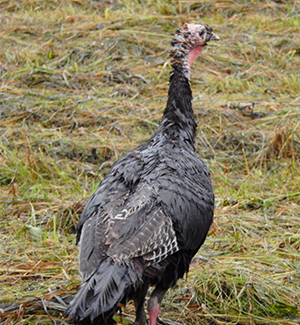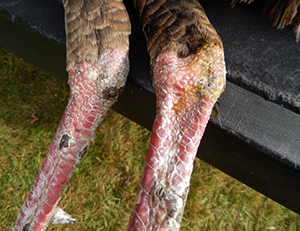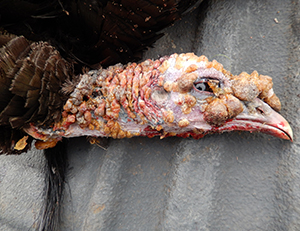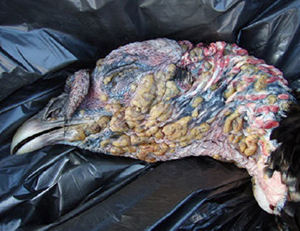Wild Turkey Viruses
Information on Avian Pox and Lymphoproliferative Disease Virus (LPDV)
There are two viruses present in the wild turkey population that may produce visible wart-like growths or lesions on the head, neck or other non-feathered parts of the bird:
Avian Pox Virus has been present in the U.S. for decades and Lymphoproliferative Disease Virus was first reported in the U.S in 2009.
New Hampshire Fish and Game has been monitoring the prevalence of symptomatic turkeys since 2011. While numerous reports from all parts of the state have been received of birds displaying physical symptoms, these viruses do not appear to be having a negative impact on the turkey population in the state.
The first two affected turkeys were collected in North Haverhill, N.H. in October 2011. In 2011 and 2012, sick turkeys were observed and specimens were collected and sent to state veterinary labs in New Hampshire. Some of the turkey specimens sent for analysis were diagnosed as having both LPDV and avian pox viruses.
In 2013 New Hampshire hunters donated the legs from their harvested turkeys which were sent to the National Wildlife Disease Lab in Georgia. It was found that approximately 71% carried LPDV but only a small number of turkeys actually displayed physical symptoms.
There are no known human health implications associated with either LPDV or avian pox. The viruses are not harmful or transferable to humans.
New Hampshire Fish and Game continues to monitor the prevalence of symptomatic turkeys via two annual online surveys. Anyone seeing turkeys displaying physical signs of these viruses is asked to report their observations here:
Winter Flock Survey (January 1 through March 31)
Summer Brood Survey (June 1 though August 31)







